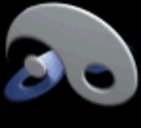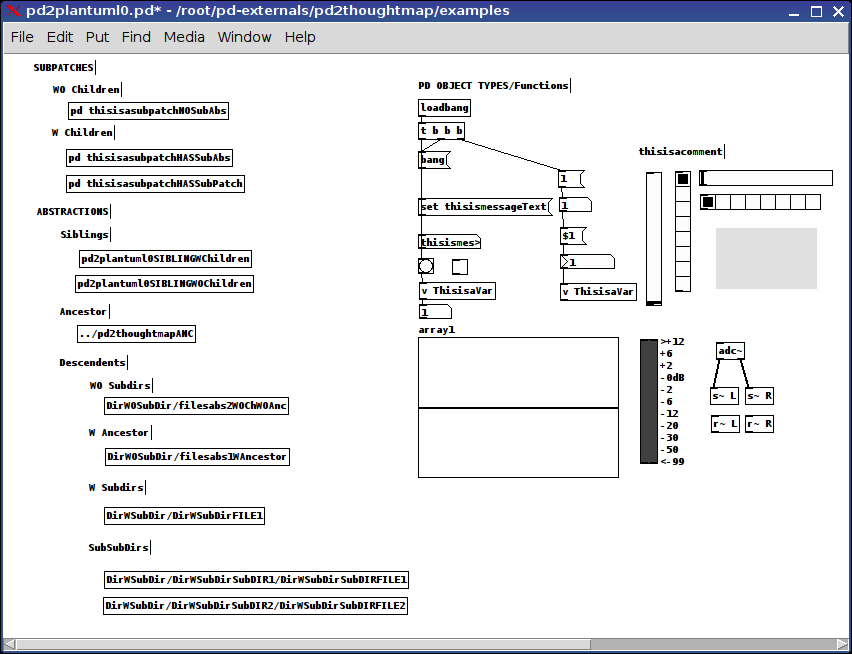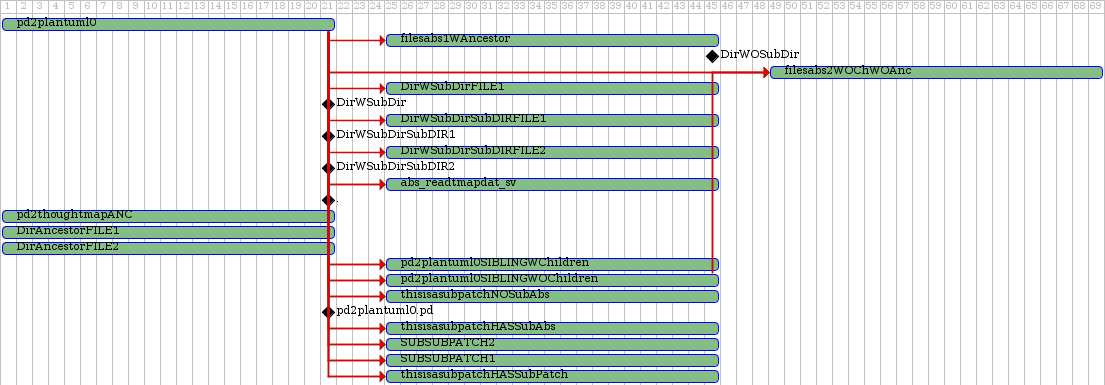Background:
The project I have been working on, for over a year now, began to be more complex than I was able to visualize.
As such, I was required to build something which would allow me to "see" it in its entirety.
NOT the audio stream, passing from one object to another, nor the variables, nor sends.
But rather, I needed to see my objects, i.e. subpatches and abstractions themselves. And how they were embedded within one another. I needed to see the "programmatic-flow" from one sub-object to the next.
Which is how this came about. Examples:
simple example

1.poly.synth

Preface:
Miller's bi-recursive/toroidal loop function, i.e. going "../" up and/or going down "/x/y/z.pd" the embedded object-tree has (thus far  eluded me. So the patch for now only recurses down the tree.
eluded me. So the patch for now only recurses down the tree.
Purpose:
By setting up a "Send-To" link to ".pd" filetypes (within Linux), one is able to right-click and send any ".pd" file to the pd2thoughtmap shell script and after a brief time (depending on the complexity of the patch). the "defaultbrowser" will open with a plantuml (http:///www.plantuml.com) usecase diagram showing the "object-flow" from one nested object to the next (clipping branches which have no embedded abstractions).
My hope has been the benefit I have/can gain from this tool, will also benefit the pd community and folks in being able to better "see" what they have done. And how to better organize their patches to suit their vision, the need of the project, or just plain Efficiency.
Instructions:
1-Download the pd2thoughtmap.zip file: pd2thoughtmapv0.1.zip
2-Unzip the file into the /root/pd-externals directory;
3-Right-click on a ".pd" file and go to ~"Configure Send-To" or the equivalent for your linux system;
4-Symlink from the /root/pd-externals/pd2thoughtmap/pd2thoughtmap shell script to the Send-To folder for ".pd" files
5-Right-click on a .pd file and "Send-To pd2thoughtmap";
6-After a pause, your default browser will open with the thoughtmap in a tab. (If your browser is already open it will just open another tab).
note: file processing is managed in the /tmp/pd2thoughtmap folder so unloaded at shutdown.
May this tool expedite your auditory "vision" and  make it easier for you to comprehend.
make it easier for you to comprehend.
Peace, Love, and Music through us all,
Scott
Footnotes:
It recurses down (the directory-tree finding descendants) just fine but will not go up (find predecessors/ancestors).
It will not recurse abstractions if the filenames have more than one period (i.e. the one in the ".pd" suffix).
It Excludes native pd abstractions/classes, ex. [adc~], etc., if they are 1) on the res/objectlist.txt, 2) a ".pd_linux" file in the pure data paths, i.e. "/root/pd-externals/", "/usr/lib/pd/extra/", or "/usr/lib/puredata/". or 3) manually entered into the "res/exclude.txt" file (in the case where one abstraction is repeated many times and you want to ignore it).
If using the command line, there are four total parameters available (to be used all together): $1=the absolute path to the file, $2={0|1|2,3} to indicate if you want "abs and subpatches", "abs only", "subpatches only", or all pd object types, ex. messages, floatatoms, etc; and $3=the height of the image in pixels, and $4=the width of the image in pixels.
If you want me to debug something, please, attach the outputted .png and the /tmp/pd2plantuml/log.txt to your post.
If you find it outputting things that should have been excluded, you can try to eliminate them by adding the object name to the exclude.txt file. This inconsistency is derived from my complete knowledge of the pd file structure. Perhaps I will address it in the future.
I need to work on the original patch for a while, so will update this patch over time and get back with you when I can.
Tally-Ho! And Joy!
-S




